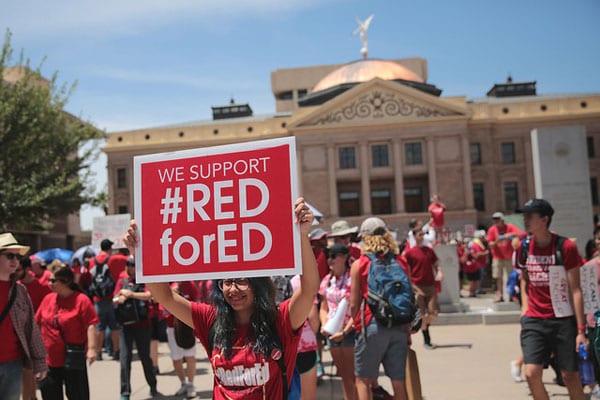
February 21, 2019; The Conversation
NPQ’s reporting on the upstart #RedForEd phenomenon started in spring 2018, as the movement had spread to Oklahoma, Arizona, and Kentucky, following West Virginia’s lead. At the time, motivations for the teacher union protests and strike actions seemed almost mundane in their predictability: teachers wanting better pay and more funding for education. Writing in the New York Times, Dana Goldstein attributed “pent-up rage over years of pay freezes and budget cuts” as the fuel for the walkouts.
Colorado was soon to follow, and an increasing level of #RedForEd sophistication and activism was emerging. Messaging continued to bring attention to teacher salaries and education funding cuts, but also focused on taxation, public policy, and broader social implications about public spending choices and their impact.
Whether or not these messages would cut through the noise and have a meaningful impact beyond the picket lines was a question soon answered in Oklahoma, in the form of stunning state election results. CNN reported on August 29th that “of the nineteen legislators who voted against a teacher pay bill in the state House, fifteen now won’t be returning to Oklahoma City next year: eight lost their primaries, four are not running for office and three are leaving because of term limits.”
University of Oklahoma political science professor Keith Gaddie was one of many to credit #RedForEd for making education a bona fide election issue. “The educators made this happen…OEA was one of several players that contributed to the downfall of these lawmakers.”
Skipping ahead to February 2019 and events in California, the movement is not only referencing social justice issues, they are at the heart of the messaging, as illustrated by the recent comments of Oakland Education Association president Keith Brown.
These school closures are specifically targeting black and brown communities—that’s why the fight for public education is a fight for racial justice.
Writing in The Nation, Eric Blanc, former high school teacher and author of the soon-to-be released book from Verso titled Red State Revolt: The Teachers’ Strike Wave and Working-Class Politics, framed the Oakland strike action as a class struggle.
Sign up for our free newsletters
Subscribe to NPQ's newsletters to have our top stories delivered directly to your inbox.
By signing up, you agree to our privacy policy and terms of use, and to receive messages from NPQ and our partners.
This is fundamentally a struggle to save Oakland’s schools from the downsizing plans of billionaire privatizers. Oakland already has a higher percent of charter students than any other city in California—and this number is set to skyrocket if the school board is allowed to move forward with its plan to close 24 of the city’s 87 public schools.
Having studied teacher unions and teacher movements from Mexico to Brazil to West Virginia, Rebecca Tarlau, Assistant Professor of Education and of Labor and Employment Relations at Pennsylvania State University, digs into the emerging social justice motivations of #RedForEd and associated teacher uprisings. Writing in The Conversation on February 21, Tarlau makes note of some important commonalities:
I’ve learned that certain conditions prompt teacher unions to adopt new forms of activism and take up broader issues of social justice that go beyond how much teachers are paid. Now is such a time in the United States.
According to Tarlau, the current wave of teacher actions in the US breaks down to three main factors:
- the acceleration of market-based education reforms, including the expansion of charter schools
- networks of teacher activists transforming their unions to focus on broader social issues
- the framing of teacher union action as part of the struggle for racial justice
Because #RedForEd has managed to break out of the “more pay, more funding” messaging bubble and into issues that connect with other citizens, the teacher unions have formed successful and impactful alliances with community organizations, students, and parents who are speaking out as a unified voice.
Unlike some teacher movements in other parts of the world (including Mexico and Brazil), actions in the United States do not have a strong historical association with broader social movements. In fact, although there were some alliances between teacher groups and other contributors to the civil rights movement, in the 1968 Ocean Hill-Brownsville Strike, the United Federation of Teachers rallied against black community control of schools.
Times have changed, and there have been hints over the past decade that new alliances were forming. The Chicago Caucus of Rank and File Educators joined with students and parents in an occupation to fight school closures in 2012; the L.A. Schools that Students Deserve campaign was a massive coalition of teachers, unions, and community groups that developed in 2014; and, the six-day L.A. strike that ended on January 22 of this year drew a wide range of supporters that included not only firefighters and celebrities, but also Black Lives Matter At School.
Tarlau clearly sees #RedForEd as more of a permanent shift in focus than a messaging campaign that is temporary to our times. “Teacher unions are not always—and not often—the leaders of broader social justice movements. Now that’s changing due to a new generation of union activists who see their struggle as part of the fight for equitable resources for the communities in which they teach.”—Keenan Wellar













